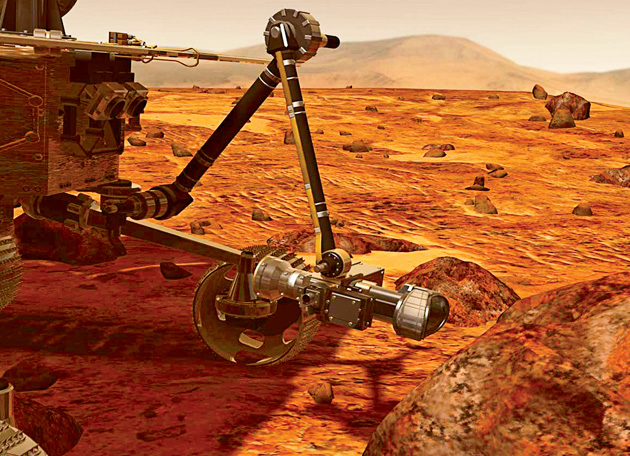
The Mars rover Opportunity is sampling a novel rock type from the planet’s 22,000-meter-wide Endeavour Crater.
Much older than the sedimentary samples the rover has “tasted” so far, this new sample is flush with the promise of revealing clues to the planet’s environment when running rivers coursed the surface.
Launched the summer of 2003 and landing in January 2004, the solar-powered Mars Exploration Rover (MER) Opportunity completed its intended basic mission in April 2004. Raymond E. Arvidson, PhD, the James S. McDonnell Distinguished University Professor in Arts & Sciences, is the MER deputy principal investigator.
NASA recently selected Arvidson to be a participating scientist on the Mars Science Laboratory, a mission to land and operate a rover named Curiosity on the surface of Mars. • Five times larger than Spirit or Opportunity, it carries much more sophisticated analytical equipment.
“Opportunity now is in a brand-new mission,” Arvidson says. “We are looking at a rock named Tisdale, with a composition unlike any we’ve seen before. It has an enormous amount of zinc, bromine, phosphorus, chlorine and sulfur, all elements that are mobile in the presence of water.
“The ancient rim of Endeavour represents a period when there was probably a lot more water on the surface,” Arvidson says. “So, we’re trying to get the chemical, mineralogical and geological setting to ‘back out’ those ancient conditions to reconstruct environmental conditions during this earlier time period.”
Arvidson and his WUSTL colleagues also are part of the Compact Reconnaissance Imaging Spectrometer for Mars (CRISM) team of the Mars Reconnaissance Orbiter, a craft orbiting Mars. The orbiter contains sophisticated instrumentation that helps Arvidson and other NASA scientists determine where Opportunity should try to go next.
CRISM spectral data and other orbital data on the part of the Endeavour Crater rim named Cape York indicate a good possibility that clay minerals would be found there.
“Our hypothesis is that if there are clay minerals, the water was less acidic and therefore more conducive to life,” Arvidson says.
NASA recently selected Arvidson to be a participating scientist on the Mars Science Laboratory, a mission to land and operate a rover named Curiosity on the surface of Mars.
Curiosity lifted off Nov. 26, 2011, and is scheduled to arrive at the Red Planet in August 2012. Five times larger than Spirit or Opportunity, it carries much more sophisticated analytical equipment.
Arvidson proposed to NASA that he use the rover itself to study Martian soil properties.
For more information on the Mars Exploration Rovers, visit marsrover.nasa.gov.
Read more about Opportunity’s mission.
To learn more about Arvidson’s upcoming work with Curiosity, visit the university’s Newsroom.

Comments and respectful dialogue are encouraged, but content will be moderated. Please, no personal attacks, obscenity or profanity, selling of commercial products, or endorsements of political candidates or positions. We reserve the right to remove any inappropriate comments. We also cannot address individual medical concerns or provide medical advice in this forum.